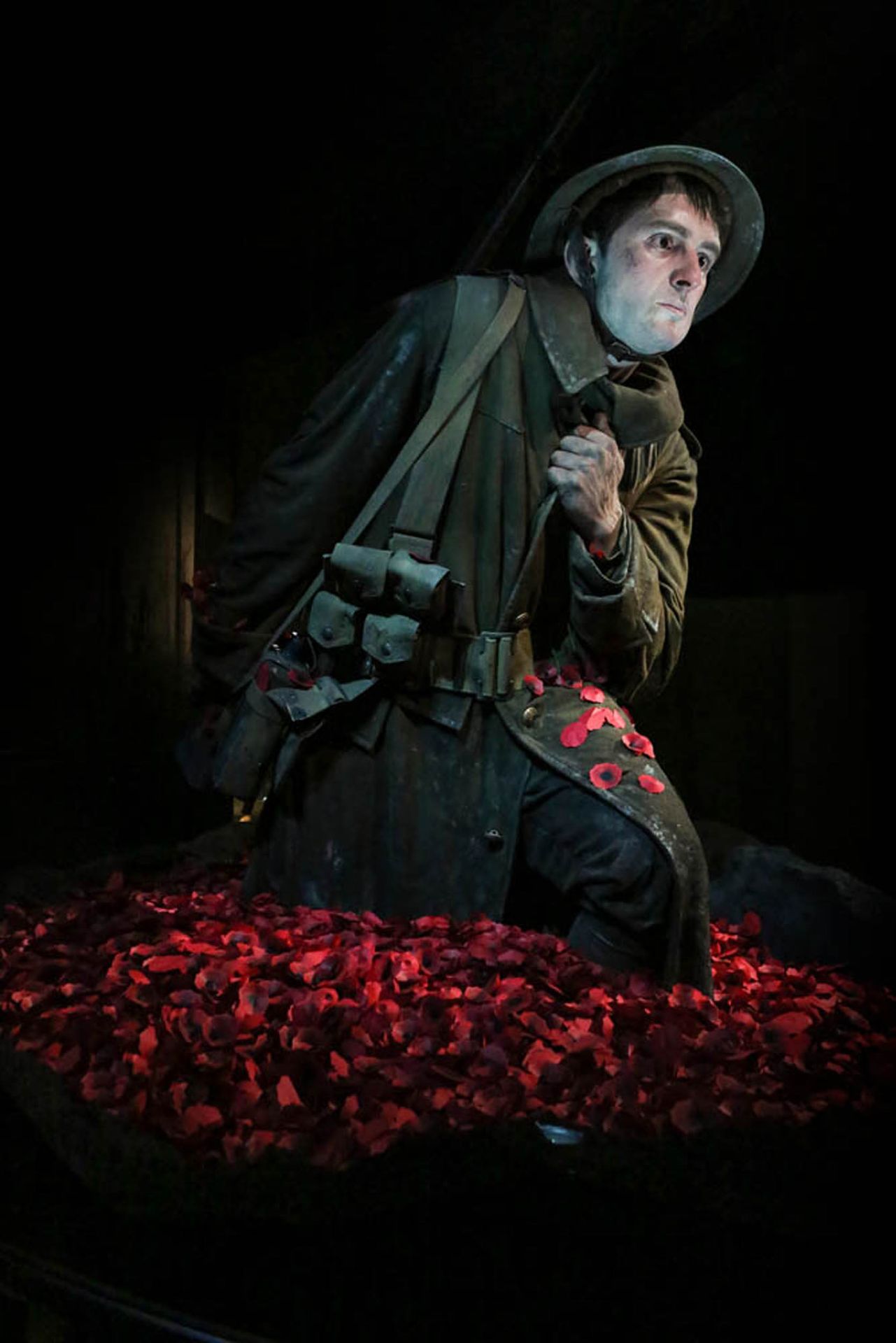The Bug Lab
Immersive experiences • Design • Manufacture • Museum exhibitions • Travelling exhibitions
Video courtesy of Te Papa
The Bug Lab
Immersive experiences • Design
• Manufacture • Museum exhibitions • Travelling exhibitions
An awe-inspiring exhibition on the beauty of bugs
Zombies. Fighter pilots. Barbarians. Supermodels. No, they’re not the stars of the latest fantastical blockbuster. In 2016, Wētā Workshop collaborated with Wellington's national museum Te Papa to celebrate the unbelievable creatures that live all around us.
Bug Lab was the second major collaboration between Wētā Workshop and New Zealand’s national museum, Te Papa. Like the record-breaking Gallipoli: The Scale of Our War, the exhibition aimed to use its dazzling spectacle to leave a deep and thought-provoking impact on visitors. In the case of Bug Lab, it was all about helping future generations to see the ways bugs enrich our lives — however grotesque they might look on the outside.
Project gallery
When us humans stepped inside Bug Lab, we were at the mercy of a clan of alien-like beings who had taken it upon themselves to demonstrate their amazing abilities, in the most eye-catching of ways. Wētā Workshop was proud to have the opportunity to bring the beauty and wonder of the bugs’ world to life, so that we may learn from them.
An awe-inspiring exhibition on the beauty of bugs
Zombies. Fighter pilots. Barbarians. Supermodels. No, they’re not the stars of the latest fantastical blockbuster. In 2016, Wētā Workshop collaborated with Wellington's national museum Te Papa to celebrate the unbelievable creatures that live all around us.
Bug Lab was the second major collaboration between Wētā Workshop and New Zealand’s national museum, Te Papa. Like the record-breaking Gallipoli: The Scale of Our War, the exhibition aimed to use its dazzling spectacle to leave a deep and thought-provoking impact on visitors. In the case of Bug Lab, it was all about helping future generations to see the ways bugs enrich our lives — however grotesque they might look on the outside.
Project gallery
When us humans stepped inside Bug Lab, we were at the mercy of a clan of alien-like beings who had taken it upon themselves to demonstrate their amazing abilities, in the most eye-catching of ways. Wētā Workshop was proud to have the opportunity to bring the beauty and wonder of the bugs’ world to life, so that we may learn from them.
Working with Te Papa’s lead exhibition team, including Te Papa head of design Ben Barraud, principal designer Clayton McGregor and head of exhibition content Frith Williams, the Wētā Workshop Design Studio helped to evolve the initial concept. Says Tasha Guillot, design studio project manager: “We knew that Te Papa wanted to explore the genius of bugs. From that, we started to explore, okay, how do you show their amazing abilities in the best way? It was a really exciting subject for us.”
One idea that took hold was inspired by a P.T. Barnum-esque carnival setting. Explains Tasha: “Barnum would have these incredible characters on show, but he would tease his audience, hiding them away in tents. You’d step inside and this character would be revealed, and you’d discover their amazing ability which you wouldn’t be able to see anywhere else. It was all about the anticipation and the build-up.”
Adds Wētā Workshop art director Ben Hawker: “It had a dual purpose, too, this idea of tents, because it created an atmosphere. We used examples from things like the World Fair where scientists were exhibitors. We thought, well, maybe that’s the angle. So we tried to make a distinction to say, perhaps bugs are the scientists and they’re showing us humans their wares.”
Who’s the fairest of them all
With nearly one million species of arthropods to choose from, deciding on the select few who would inhabit these ‘tents’ was a daunting task. Luckily, Te Papa already had a shortlist in mind. “You can only build so many. And that was tricky because, of course, when you’re building big ones, you want to build the coolest-looking things ever,” says Ben.
The designers had the benefit of working with Te Papa’s team of experts, including spider biologist Dr. Simon Pollard, “Bugman” Ruud Kleinpaste, and entomologist Dr. Phil Sirvid. In the end, they were left with four bona fide bug geniuses: the Jewel Wasp, the Orchid Mantis, the Dragonfly, and the Japanese bee.
Each insect was selected as much for their amazing abilities, as for their stunning insectoid plumage. The Orchid Mantis, according to Tasha, was a prime example of that. “You could tell a similar story about amazing adaption and mimicry with a humble stick insect, but it was about what was going to be the most visually impactful. This was a character who adapts to her surroundings, not to hide, but to attract and stand out."
Bug Nouveau
To ensure the overall look of the exhibition matched the organic beauty of the bugs, the Design Studio adopted a term coined by Richard: ‘Bug Nouveau.’
“That’s what ended up being the grounding point, the real ‘click’ moment,” says Tasha. “Instead of straight, man-made lines, we needed to make it look as though the bugs created this exhibition themselves.”
‘Bug Nouveau’ helped the Wētā Workshop crew home in on a unique “buggy” aesthetic, visualising giant chambers with facades made up of undulating lines. This organic look was woven all the way through the exhibition; you can even see it in the Bug Lab font style, expertly conceptualised by one of the Design Studio’s newest members, Tahiwi Trenor-Hunt. In fact, everything in this exhibition was ‘bugified’ with not a straight line in sight — right down to the finish on the lab tables, manufactured by Te Mahi and painted by Wētā Workshop in the likeness of each chamber.
Working with Te Papa’s lead exhibition team, including Te Papa head of design Ben Barraud, principal designer Clayton McGregor and head of exhibition content Frith Williams, the Wētā Workshop Design Studio helped to evolve the initial concept. Says Tasha Guillot, design studio project manager: “We knew that Te Papa wanted to explore the genius of bugs. From that, we started to explore, okay, how do you show their amazing abilities in the best way? It was a really exciting subject for us.”
One idea that took hold was inspired by a P.T. Barnum-esque carnival setting. Explains Tasha: “Barnum would have these incredible characters on show, but he would tease his audience, hiding them away in tents. You’d step inside and this character would be revealed, and you’d discover their amazing ability which you wouldn’t be able to see anywhere else. It was all about the anticipation and the build-up.”
Adds Wētā Workshop art director Ben Hawker: “It had a dual purpose, too, this idea of tents, because it created an atmosphere. We used examples from things like the World Fair where scientists were exhibitors. We thought, well, maybe that’s the angle. So we tried to make a distinction to say, perhaps bugs are the scientists and they’re showing us humans their wares.”
With nearly one million species of arthropods to choose from, deciding on the select few who would inhabit these ‘tents’ was a daunting task. Luckily, Te Papa already had a shortlist in mind. “You can only build so many. And that was tricky because, of course, when you’re building big ones, you want to build the coolest-looking things ever,” says Ben.
The designers had the benefit of working with Te Papa’s team of experts, including spider biologist Dr. Simon Pollard, “Bugman” Ruud Kleinpaste, and entomologist Dr. Phil Sirvid. In the end, they were left with four bona fide bug geniuses: the Jewel Wasp, the Orchid Mantis, the Dragonfly, and the Japanese bee.
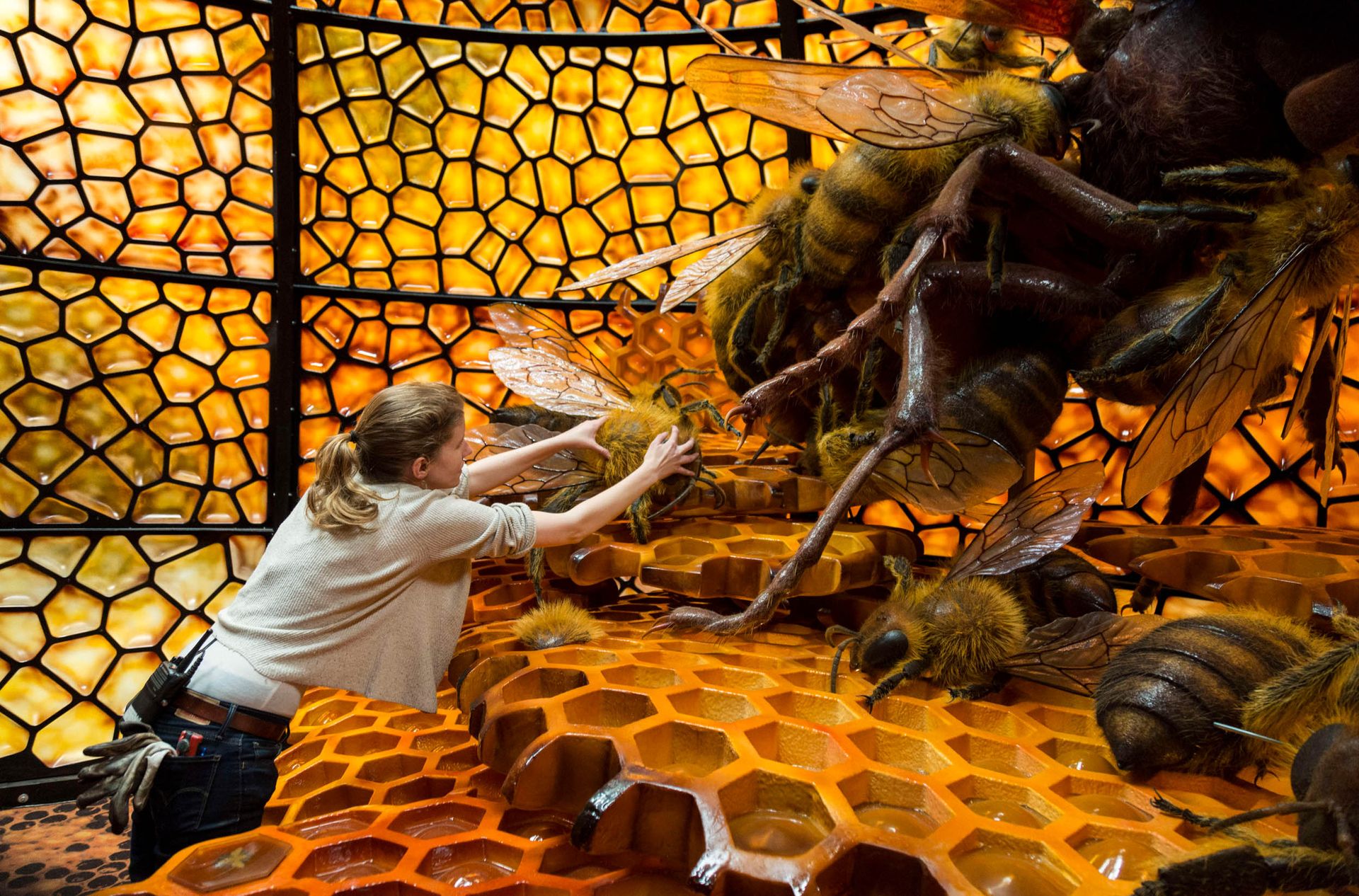
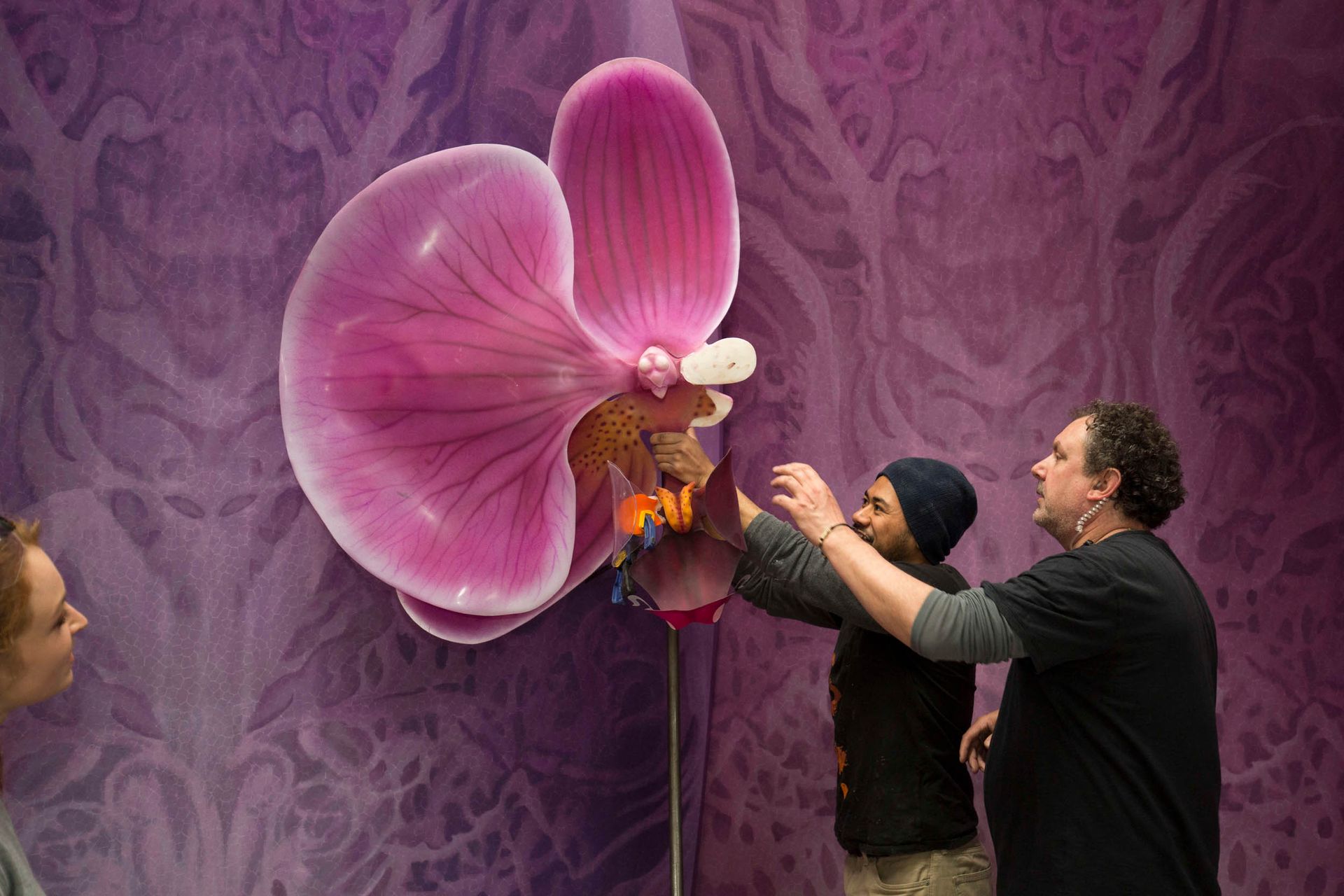
Each insect was selected as much for their amazing abilities, as for their stunning insectoid plumage. The Orchid Mantis, according to Tasha, was a prime example of that. “You could tell a similar story about amazing adaption and mimicry with a humble stick insect, but it was about what was going to be the most visually impactful. This was a character who adapts to her surroundings, not to hide, but to attract and stand out.”
To ensure the overall look of the exhibition matched the organic beauty of the bugs, the Design Studio adopted a term coined by Richard: ‘Bug Nouveau.’
“That’s what ended up being the grounding point, the real ‘click’ moment,” says Tasha. “Instead of straight, man-made lines, we needed to make it look as though the bugs created this exhibition themselves.”
‘Bug Nouveau’ helped the Wētā Workshop crew home in on a unique “buggy” aesthetic, visualising giant chambers with facades made up of undulating lines. This organic look was woven all the way through the exhibition; you can even see it in the Bug Lab font style, expertly conceptualised by one of the Design Studio’s newest members, Tahiwi Trenor-Hunt. In fact, everything in this exhibition was ‘bugified’ with not a straight line in sight — right down to the finish on the lab tables, manufactured by Te Mahi and painted by Wētā Workshop in the likeness of each chamber.
As the exhibition began to evolve, Wētā Workshop did, too. The Design Studio became something of a think tank, where ideas were generated in an intensive back-and-forth process with Te Papa. Meanwhile, the Workshop floor found themselves stepping into a design role. Part engineers, part designers, part sculptors and part problem solvers, the 3D team, led by Project Supervisor Mona Peters, contributed their own ideas and played a vital role in the exhibition’s final form.
While Te Papa developed the central lab space, Wētā Workshop brought the bugs and their homes to life, creating four immersive chambers that show a single moment of the bugs’ genius.
Over a period of six months, more than 200 Wētā Workshop crew built these mini worlds from the ground up. More than 2,000 individual pieces were created: hundreds of reeds and lily pads, massive 3D printed elements (some of the largest 3D prints the workshop had ever worked with), giant fabric petals draped over steel armatures. There was a 3D printed dragonfly wing nearly half a metre long; a hulking katipo spider lying in wait; even a giant bombardier beetle slide complete with explosive sound effects. It was a bug world ‘best of’.
The workshop went to great lengths to mimic the colouring of these fascinating insects, and there was no better example of that than the Jewel Wasp. With an iridescent skin of greens and blues, its high-shine, oil slick-like finish was nearly impossible to replicate — which gave Wētā Workshop the perfect excuse to hunt down a new piece of technology.
A special chrome paint machine was sourced from Florida. Mastered by paint technician Corey Fox, this machine delivered a high chrome application, giving the wasp its unique opalescent coating. Says Tasha: “We wouldn’t have been able to make the jewel wasp without it, to the level that we were able to.” Wētā Workshop production manager Alex Guillot agrees, adding: “In the past we’ve done foiling on swords and metallic objects to give them that type of finish. But the scale of this project made it necessary to source this special high-tech gun.”
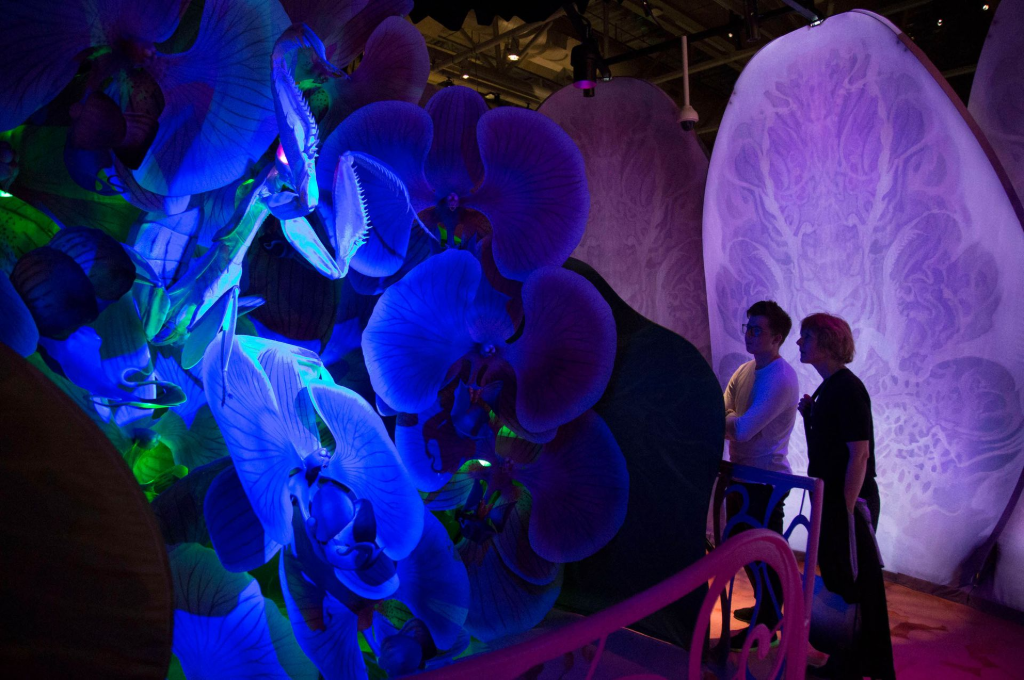
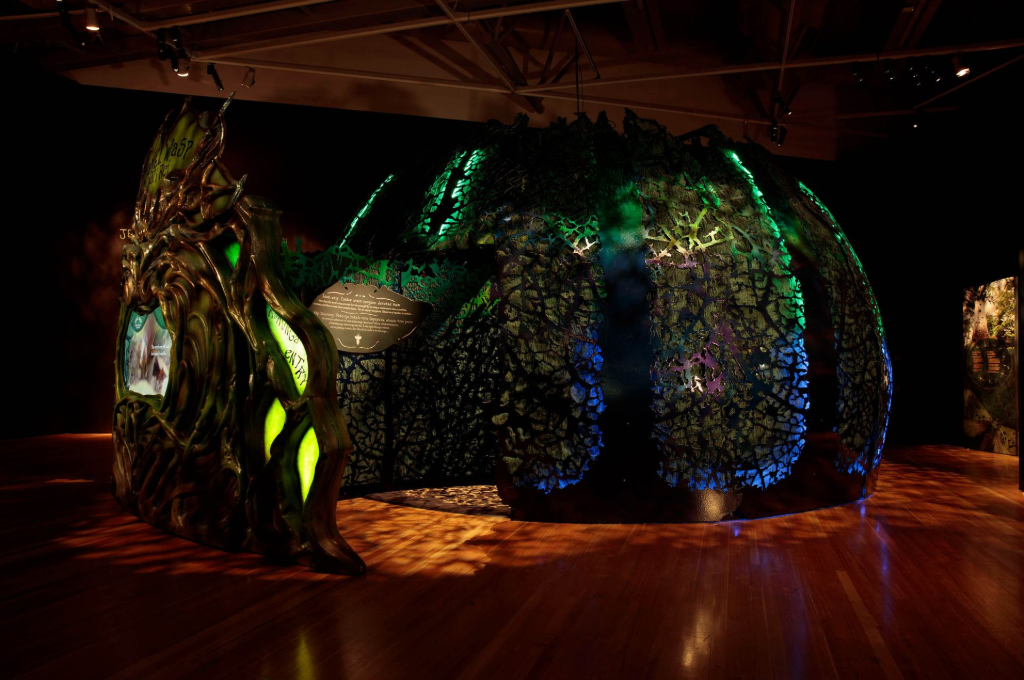
Building Bug Lab
As the exhibition began to evolve, Wētā Workshop did, too. The Design Studio became something of a think tank, where ideas were generated in an intensive back-and-forth process with Te Papa. Meanwhile, the Workshop floor found themselves stepping into a design role. Part engineers, part designers, part sculptors and part problem solvers, the 3D team, led by Project Supervisor Mona Peters, contributed their own ideas and played a vital role in the exhibition’s final form.
While Te Papa developed the central lab space, Wētā Workshop brought the bugs and their homes to life, creating four immersive chambers that show a single moment of the bugs’ genius.
Over a period of six months, more than 200 Wētā Workshop crew built these mini worlds from the ground up. More than 2,000 individual pieces were created: hundreds of reeds and lily pads, massive 3D printed elements (some of the largest 3D prints the workshop had ever worked with), giant fabric petals draped over steel armatures. There was a 3D printed dragonfly wing nearly half a metre long; a hulking katipo spider lying in wait; even a giant bombardier beetle slide complete with explosive sound effects. It was a bug world ‘best of’.
High-shine meets high-tech
The workshop went to great lengths to mimic the colouring of these fascinating insects, and there was no better example of that than the Jewel Wasp. With an iridescent skin of greens and blues, its high-shine, oil slick-like finish was nearly impossible to replicate — which gave Wētā Workshop the perfect excuse to hunt down a new piece of technology.
A special chrome paint machine was sourced from Florida. Mastered by paint technician Corey Fox, this machine delivered a high chrome application, giving the wasp its unique opalescent coating. Says Tasha: “We wouldn’t have been able to make the jewel wasp without it, to the level that we were able to.” Wētā Workshop production manager Alex Guillot agrees, adding: “In the past we’ve done foiling on swords and metallic objects to give them that type of finish. But the scale of this project made it necessary to source this special high-tech gun.”
The chrome gun would prove its worth in other ways, too. It gave a beautiful metallic sheen to the four chamber facades, which each had their own unique colour palette and design inspired by the bugs’ environment, from sinuous deep green leaf patterns to golden honeycomb. Each open-topped chamber features its own bespoke carpet in the likeness of its surroundings.
One of the things is not like the others
Take a wander through the world these bugs have built, and something odd will soon become apparent: one chamber is missing its giant master. It’s the dragonfly chamber, and it was one of the hardest to conceptualise.
“The dragonfly was one of the last ones to put our finger on,” says Tasha. “We knew we had to do something with movement, because the genius of that bug is how fast it moves and observes the world. Doing any sort of static sculpture, no matter how amazing it looks, was never going to capture that message.”
The answer lay in an old pre-film animation technique: the zoetrope. Explains Alex: “It’s sort of the way a flip book works. Basically, it’s a whole bunch of different small-scale models and there’s light flashing at the rate at which we see, which gives the impression that these items are in motion.”
A simple enough idea, but — as you’d expect — Wētā Workshop’s involvement meant a sophisticated execution. To help sell the idea to Te Papa, the Workshop crew created a mock-up. It was no bigger than a dinner plate, but that was all it took. According to Ben: “It just told the story so well and in such an engaging way, it was the obvious choice.”
Translating the design into a fully functioning object was a hugely technical undertaking for the Workshop floor. The crew manufactured an incredible large-scale zoetrope which reveals itself from a shiny silver dome. With dragonflies jostling for attention among leaping frog and fish, splashing and swimming through clear acrylic ‘water’, and a stroboscopic light casting shadows across the chamber interior, “the cumulative effect,” says Ben, “is magic”.
An interactive experience
Just like Gallipoli: The Scale of Our War, Bug Lab represents a collaboration between many Wellington companies; among them, Toulouse Group, creators of amazing lighting displays. Managing director Marc Simpson was involved from the earliest stages, working with Te Papa and Wētā Workshop to design a light show that was atmospheric, moody — even, at times, responsive.
Visuals, of course, are just one part of creating a fully immersive world. You’ve got to hear it, feel it — even smell it, too. The Bug Lab had it all, right down to individual incense designed for each chamber. The exhibition’s soundtrack was crafted by award-winning composer and sound designer Tane Upjohn-Beatson, a fellow Wellingtonian who worked with the team on Gallipoli: The Scale of Our War. Tane created a soundscape for each chamber, and yet, when you stand in the middle of it all, the composition resonates through the space as a unified whole; a special kind of aural magic.
With interactivity a major highlight, the workshop had the chance to flex its muscles on the creation of a tactile experience. “We have that cinematic background, but we’re learning more and more about ways to create tactile objects that really help people engage,” says Ben. “For an exhibition about bugs, that was especially important.”
To that end, Wētā Workshop provided a number of interactive elements which complemented those created by Te Papa. Guests could perform surgery on a cockroach, mimic the deadly spray of a bombardier beetle, and save a beehive from a terrible fate by utilising the wonders of friction.
The chrome gun would prove its worth in other ways, too. It gave a beautiful metallic sheen to the four chamber facades, which each had their own unique colour palette and design inspired by the bugs’ environment, from sinuous deep green leaf patterns to golden honeycomb. Each open-topped chamber features its own bespoke carpet in the likeness of its surroundings.
Take a wander through the world these bugs have built, and something odd will soon become apparent: one chamber is missing its giant master. It’s the dragonfly chamber, and it was one of the hardest to conceptualise.
“The dragonfly was one of the last ones to put our finger on,” says Tasha. “We knew we had to do something with movement, because the genius of that bug is how fast it moves and observes the world. Doing any sort of static sculpture, no matter how amazing it looks, was never going to capture that message.”
The answer lay in an old pre-film animation technique: the zoetrope. Explains Alex: “It’s sort of the way a flip book works. Basically, it’s a whole bunch of different small-scale models and there’s light flashing at the rate at which we see, which gives the impression that these items are in motion.”
A simple enough idea, but — as you’d expect — Wētā Workshop’s involvement meant a sophisticated execution. To help sell the idea to Te Papa, the Workshop crew created a mock-up. It was no bigger than a dinner plate, but that was all it took. According to Ben: “It just told the story so well and in such an engaging way, it was the obvious choice.”
Translating the design into a fully functioning object was a hugely technical undertaking for the workshop floor. The crew manufactured an incredible large-scale zoetrope which reveals itself from a shiny silver dome. With dragonflies jostling for attention among leaping frog and fish, splashing and swimming through clear acrylic ‘water’, and a stroboscopic light casting shadows across the chamber interior, “the cumulative effect,” says Ben, “is magic”.
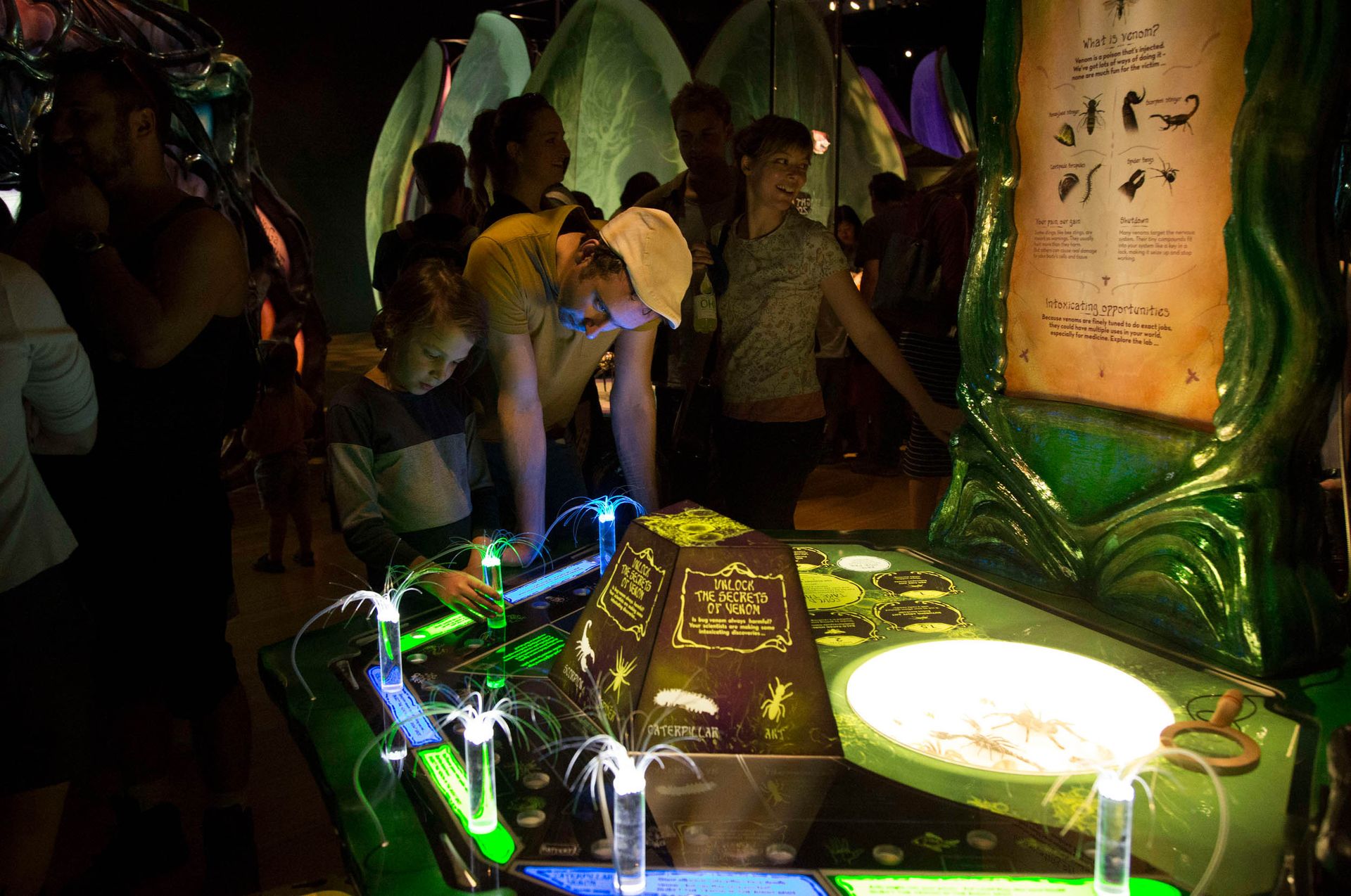
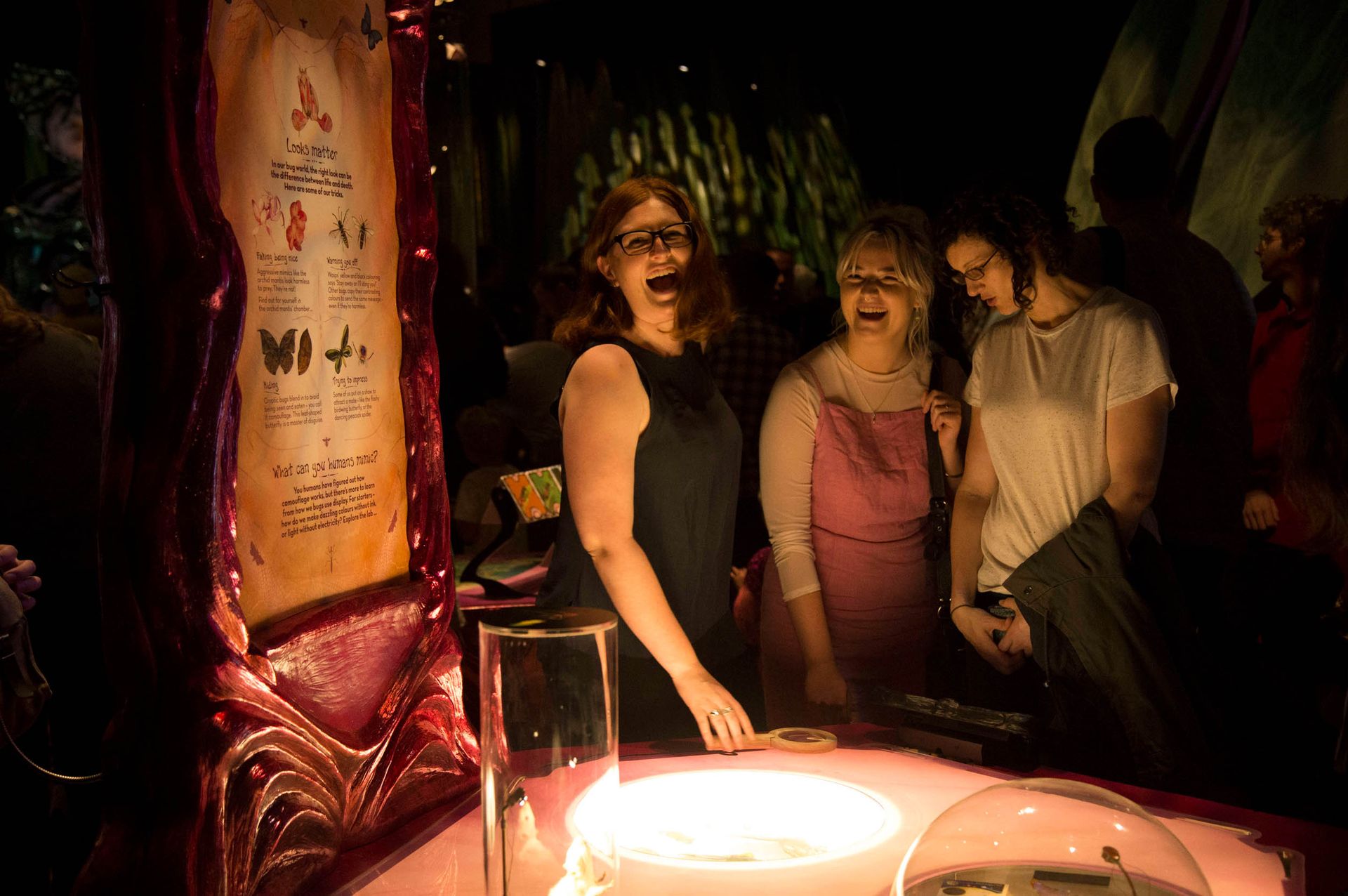
See the world the bugs have built
When us humans stepped inside Bug Lab, we were at the mercy of a clan of alien-like beings who had taken it upon themselves to demonstrate their amazing abilities, in the most eye-catching of ways. Wētā Workshop was proud to have the opportunity to bring the beauty and wonder of the bugs’ world to life, so that we may learn from them.
“I like to think of it as if the bugs were observing everything that the humans were doing and went, ‘listen, these guys need to learn a lesson from us’… It’s a nice idea that they’d go, ‘who would be the best people to work with?’ Of course Wētā Workshop, being a wētā bug, would be the ones to collaborate with Te Papa and the bugs to make this exhibition.”
Just like Gallipoli: The Scale of Our War, Bug Lab represents a collaboration between many Wellington companies; among them, Toulouse Group, creators of amazing lighting displays. Managing director Marc Simpson was involved from the earliest stages, working with Te Papa and Wētā Workshop to design a light show that was atmospheric, moody — even, at times, responsive.
Visuals, of course, are just one part of creating a fully immersive world. You’ve got to hear it, feel it — even smell it, too. The Bug Lab had it all, right down to individual incense designed for each chamber. The exhibition’s soundtrack was crafted by award-winning composer and sound designer Tane Upjohn-Beatson, a fellow Wellingtonian who worked with the team on Gallipoli: The Scale of Our War. Tane created a soundscape for each chamber, and yet, when you stand in the middle of it all, the composition resonates through the space as a unified whole; a special kind of aural magic.
With interactivity a major highlight, the workshop had the chance to flex its muscles on the creation of a tactile experience. “We have that cinematic background, but we’re learning more and more about ways to create tactile objects that really help people engage,” says Ben. “For an exhibition about bugs, that was especially important.”
To that end, Wētā Workshop provided a number of interactive elements which complemented those created by Te Papa. Guests could perform surgery on a cockroach, mimic the deadly spray of a bombardier beetle, and save a beehive from a terrible fate by utilising the wonders of friction.
“I like to think of it as if the bugs were observing everything that the humans were doing and went, ‘listen, these guys need to learn a lesson from us’… It’s a nice idea that they’d go, ‘who would be the best people to work with?’ Of course Wētā Workshop, being a wētā bug, would be the ones to collaborate with Te Papa and the bugs to make this exhibition.”
“Wētā Workshop is traditionally called upon to imagine fantastical beings from imaginative worlds – but Te Papa’s Bug Lab gave us the chance to channel our creativity into the creatures of science fiction that exist right here in our own backyards. The artists and technicians of Wētā Workshop had a fantastic time collaborating with Te Papa to tell the incredible stories of the bugs that are living all around us.”
Richard Taylor
Co-founder, CEO and Chief Creative Officer at Wētā Workshop
“Wētā Workshop is traditionally called upon to imagine fantastical beings from imaginative worlds – but Te Papa’s Bug Lab gave us the chance to channel our creativity into the creatures of science fiction that exist right here in our own backyards. The artists and technicians of Wētā Workshop had a fantastic time collaborating with Te Papa to tell the incredible stories of the bugs that are living all around us.”
Richard Taylor
Co-founder, CEO and Chief Creative Officer at Wētā Workshop
Related projects
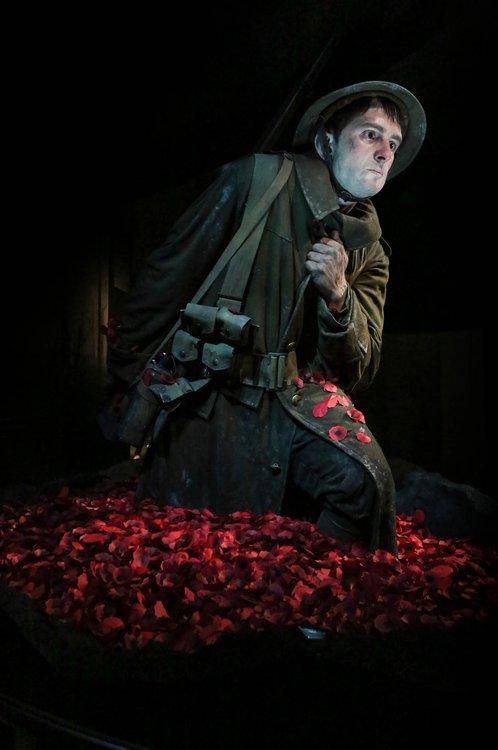
Gallipoli: The Scale of Our War
Immersive experiences • Design • Manufacture • Museum exhibitions
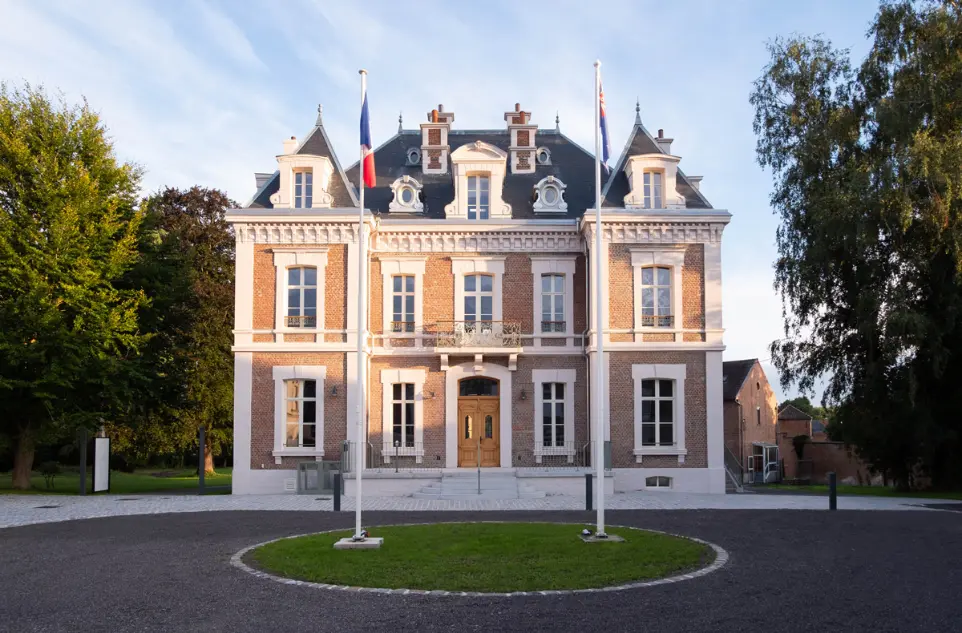
New Zealand Liberation Museum – Te Arawhata
Immersive experiences • Design • Manufacture • Museum exhibitions
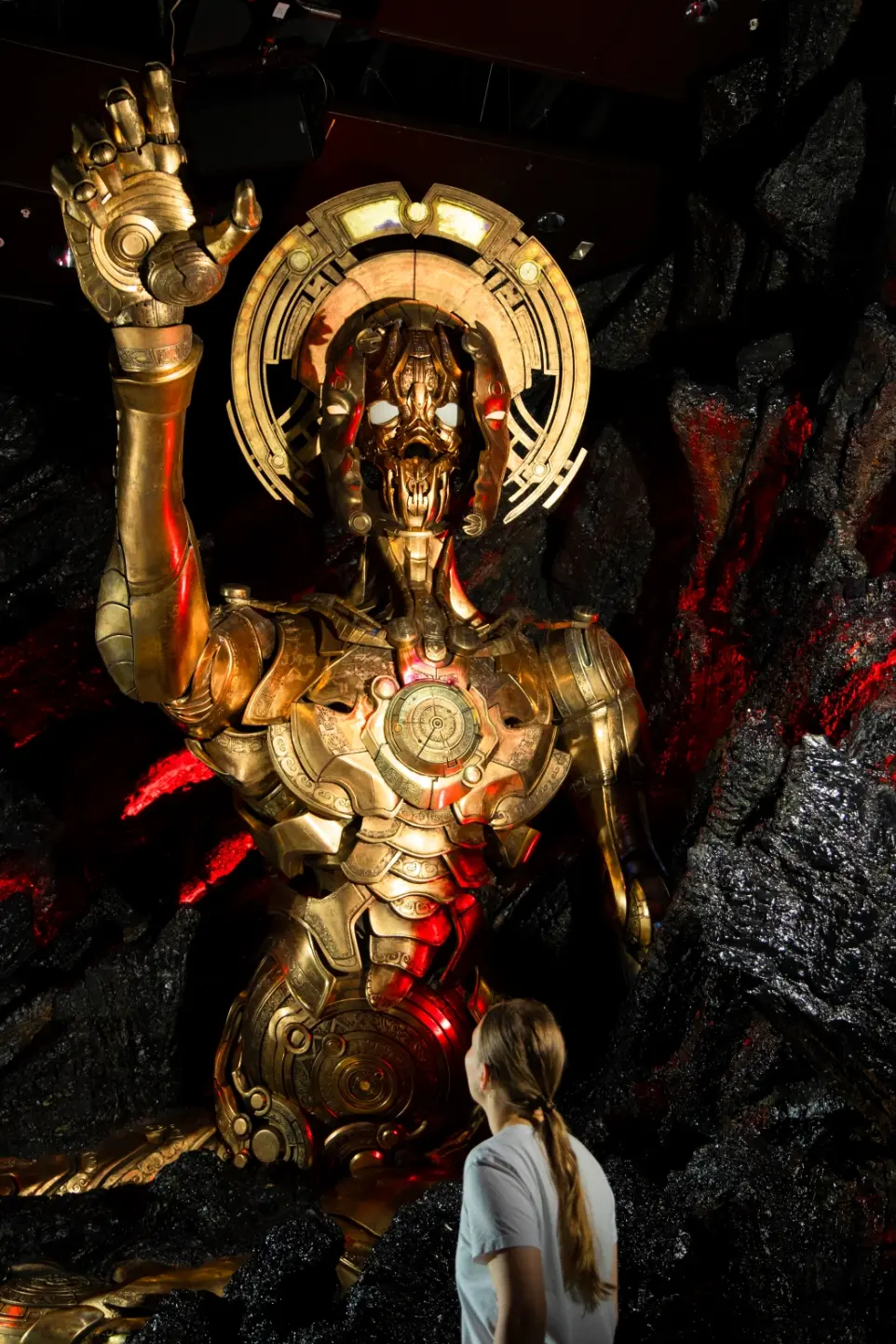
Wētā Workshop Unleashed
Immersive experiences • Design • Manufacture • Immersive art and attractions
Related projects
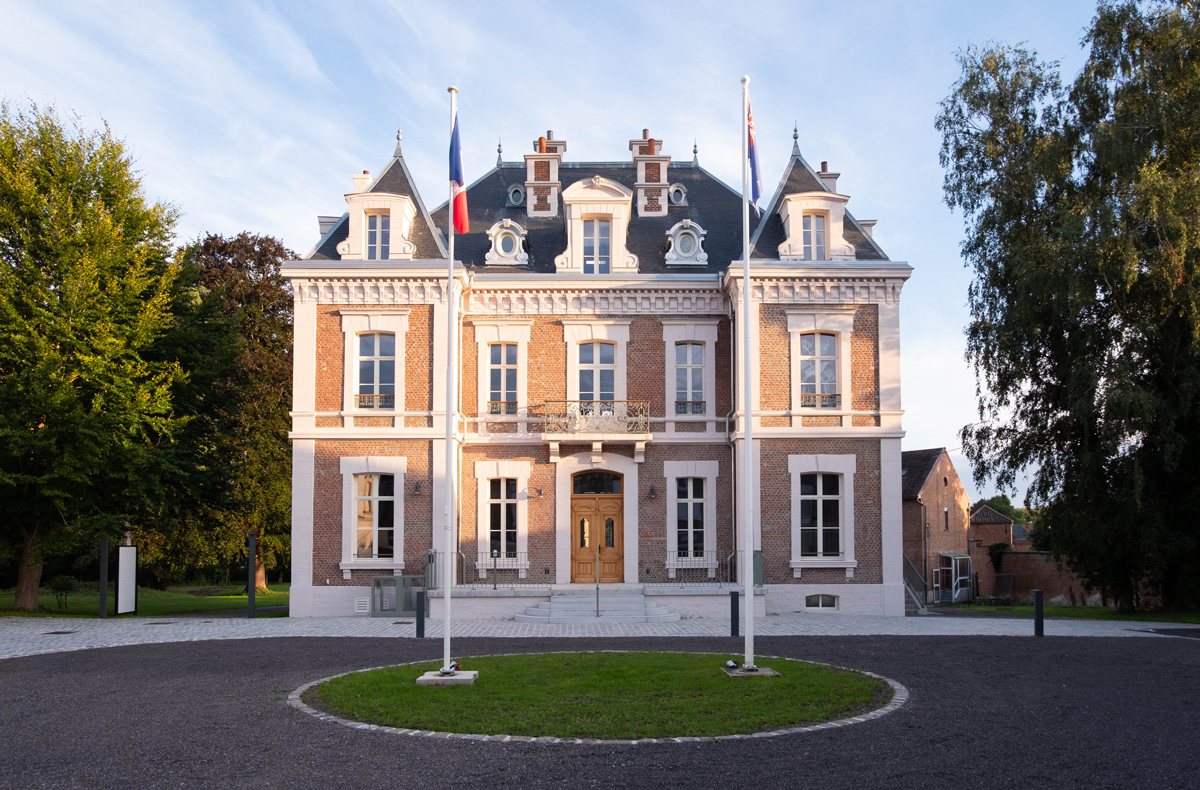
New Zealand Liberation Museum – Te Arawhata
Immersive experiences • Design • Manufacture • Museum exhibitions
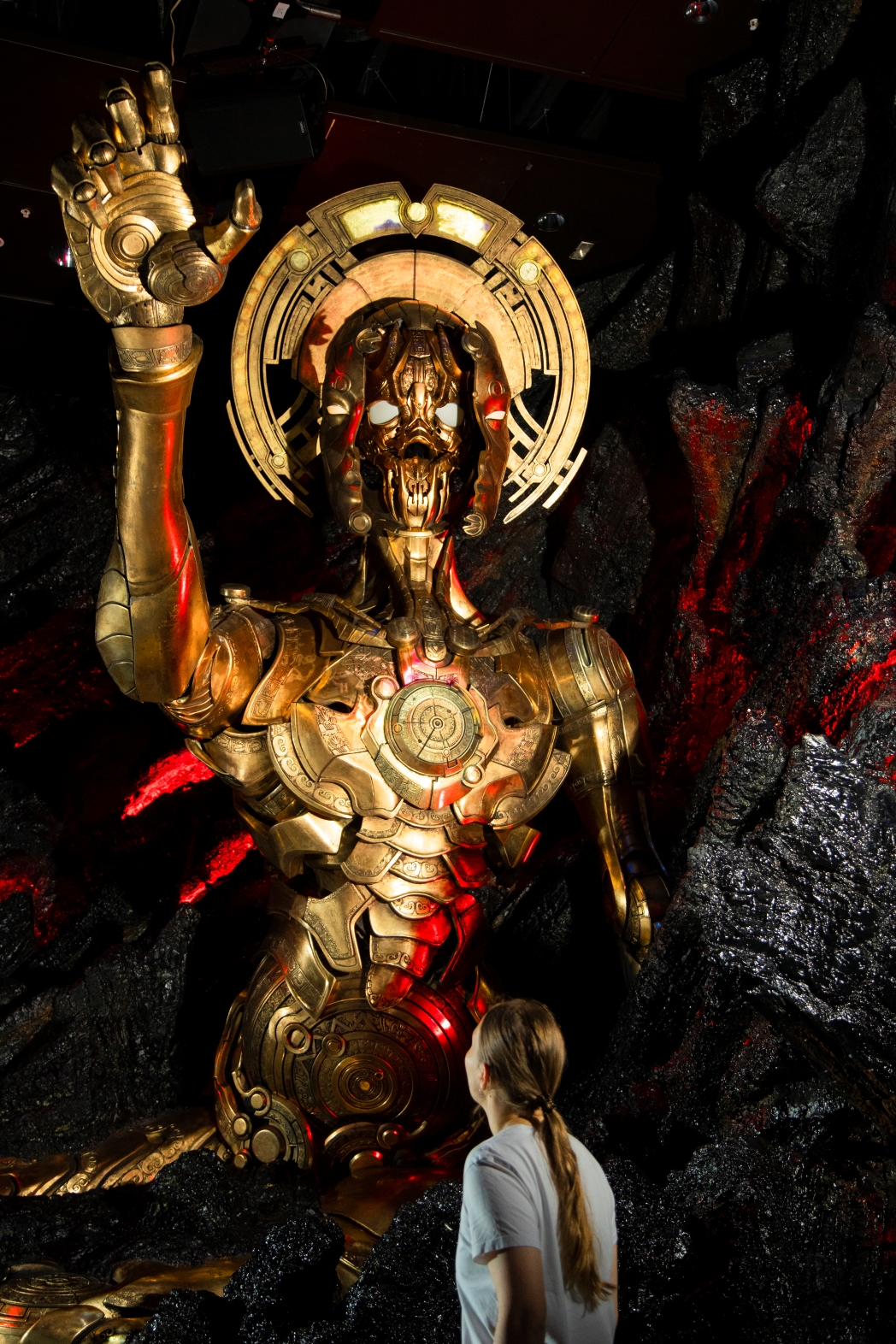
Wētā Workshop Unleashed
Immersive experiences • Design • Manufacture • Immersive art and attractions
